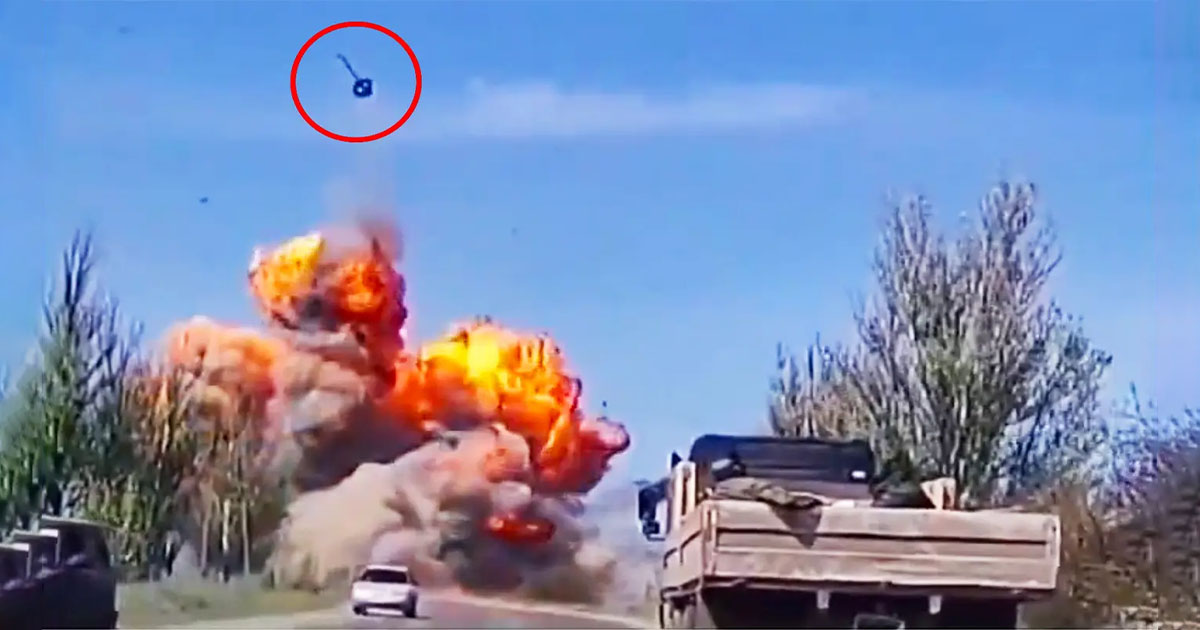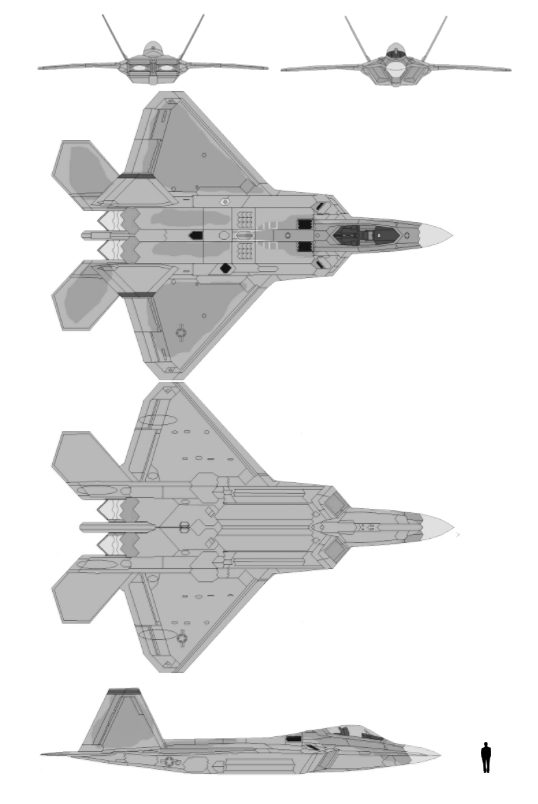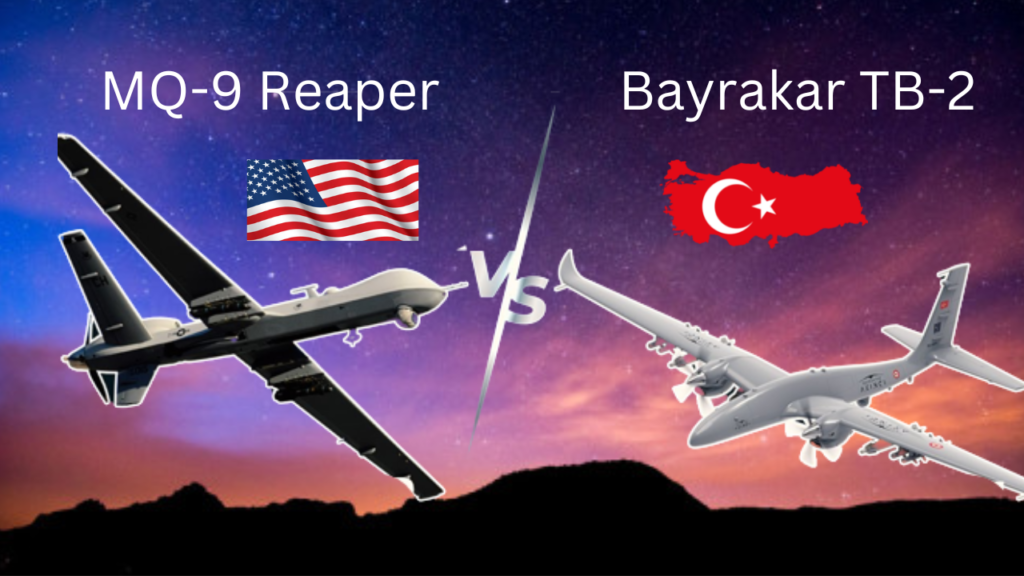
Unmanned aircraft systems (UAS) are becoming increasingly important in the military and, as a result, are swiftly altering the nature of combat on a global scale, as you well know. Modern drone warfare has attained a new level of sophistication, with the ability to either indirectly or directly interfere on the battlefield by dropping or firing precision-guided weapons or by designating targets for manned systems to drop or fire these bombs.
So let us dive into a comparison between MQ-9 Reaper and Bayrakar TB-2. But why are they being compared?
There are two reasons for this:
First, the Bayraktar TB-2 and the General Atomics MQ-9 Reaper are utterly different drones with much different mission profiles and features.
Second, both of them are very famous and counted among the most powerful unmanned aerial vehicles across the globe. One holds its national origin in the United States, and the other in Turkey. It will be very interesting to see how much they can get into cut-throat comparison.
MQ-9 Reaper
America’s preferred weapon for the upcoming global conflict is the MQ-9 Reaper drone. Due to a well-defined service plan to use the platform for at least the next 15 years, the air force MQ-9 Reaper drone will continue to combat for thousands more days.
The General Atomics MQ-9 Reaper, commonly referred to as the Predator B, is an unmanned aerial vehicle designed primarily for the US Air Force that can fly autonomously or under remote control.
Compared to the preceding General Atomic’s MQ-1 Predator, the MQ-9 is bigger, heavier, and more capable. The Reaper’s turboprop engine produces 950 shaft horsepower. The Reaper can travel at nearly three times the speed of the MQ-1 and carry 15 times more ordinance payload thanks to its increased power.
Background
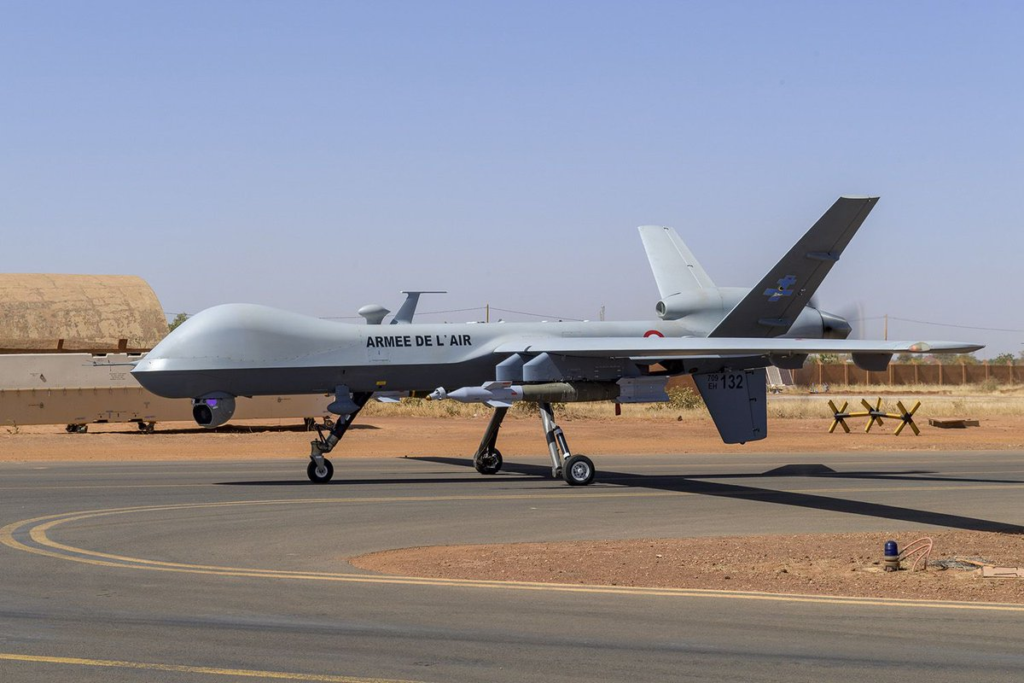
In response to a Department of Defense request to support plans for overseas contingency operations, the US Air Force proposed the MQ-9 Reaper system. It is intended to execute time-sensitive targets with persistence and precision, destroy or disable those targets, and is bigger and more powerful than the MQ-1 Predator.
The DoD abbreviation “M” stands for multi-role, and the letters “Q” stand for a remotely piloted aircraft system, according to the US Department of Defense. The “9” denotes the ninth system for remotely piloted aircraft in the series.
Features
Over several years, the air force has made considerable adjustments and migrations to the Reaper, including installing the aim 9x air-to-air missile.
The aim-9x, which can also be fired from the F-35 Lightning 2 and the F-22 Raptor, uses advanced guidance technology, such as off-bore sight targeting, to be able to destroy non-linear targets that are either behind or to the side of the aircraft but are not necessarily in a direct line of sight. Off-boresight targeting allows the missile to turn or change course while in flight.
Software improvements have increased the Reaper’s overall weapons-carrying capacity and allowed it to fly with as many as eight hellfire missiles. The Multi-Spectral Targeting System, which features a powerful array of visual sensors for targeting, is a component of the MQ-9 baseline system.
The MTS-B incorporates a laser designator, laser illuminator, color, monochrome daylight TV camera, shortwave infrared camera, and infrared sensor. You can watch the full-motion video from each of the image sensors separately or combined. A laser rangefinder/designator is another feature of the device that precisely marks targets for the use of laser-guided weapons like the Guided Bomb Unit-12 Paveway II.
Additionally, the Reaper has a synthetic aperture radar. The Air-to-Ground Missile-114 Hellfire, a laser-guided missile with high precision, minimal collateral damage, anti-armor, and anti-personnel engagement capabilities, can also be used by the MQ-9 in groups of up to eight.
Also, the MQ-9 has been upgraded to operate over longer distances by adding external fuel tanks with a 1,300 lbs (589Kg) fuel capacity. Greater on-station duration and increased range are made possible by this. In order to enhance takeoff performance, the modification also includes an additional propeller blade and an alcohol-water injection system.
Advancements and Future
The ground control station is where the aircrew monitors and controls the aircraft, including the use of armaments. The plan is to develop and maintain the MQ-9 Reaper as it transforms from a platform used primarily for counterterrorism surveillance and strikes into a great power warfare asset while becoming less stealthy and likely less resilient to advanced major power air defenses.
The air force has been utilizing the reaper drone for many years now to upgrade its technical systems and expand its mission scope in order to transition the drone into great power warfare. The reaper drone still has a tremendous amount of tactical value and utility in a potential large-scale war.
The drone’s ability to switch between different types of bombs and add new weapons to its arsenal has been improved with the installation of a universal weapons interface. This effort has been ongoing for several years.

In an effort to broaden the range of possible operations, the air force has also integrated air-to-air weapons into the Reaper and added new weapons to the drone fuel tank expansion. In order to prevent adversary jamming attempts and increase resilience and survival, the air force has most recently retrofitted the Reaper with hardening technologies.
Other reaper improvements include upgraded electro-optical and infrared sensors and the incorporation of more weaponry. The general atomics aeronautical systems announced that the MQ-9 Reaper drone is getting a new modification that will give it a short takeoff and landing capability, making it the first unmanned aerial system in its class able to take off from big deck amphibious assault ships.
The fundamental aircraft and its subsystems will remain the same, but the new short takeoff and landing stole configuration for the drone will include an optional wing and tail kit that can be added in a day. The kit can be installed by operators in a hangar or on a flight line, giving an existing aircraft a new capacity.
Latest Version of MQ-9 Reaper and its Technologies
A Rolls-Royce m250 turboshaft engine powers the most recent version of the MQ-9 has a high-resolution electro-optical, infrared nose-mounted MTS-B sensor, and can carry a variety of other capabilities through bolt-on pods, including an eagle eye long-range synthetic aperture radar with moving target indicator capability, signals intelligence, and communications relay packages.
It would be equally as effective as a networking node connecting strike groups and a neighboring battle space as a whole outside the line of sight without relying on satellites. A reaper might be an effective wide-area surveillance platform giving coverage over enormous portions of the ocean for long periods.
Bayraktar TB-2
Tactical Armed / UAV System, created and produced by Baykar, is the Bayraktar TB-2, a very advanced architecture that offers every service an operator would require in a single integrated system. Bayraktar TB2 Armed/UAV Platform, Ground Control Station, Ground Data Terminal, Remote Display Terminal, Advanced Base with Generator, and Trailer modules make up the system. The entire system is made in-house, thanks to Baykar’s technological development and capacity.
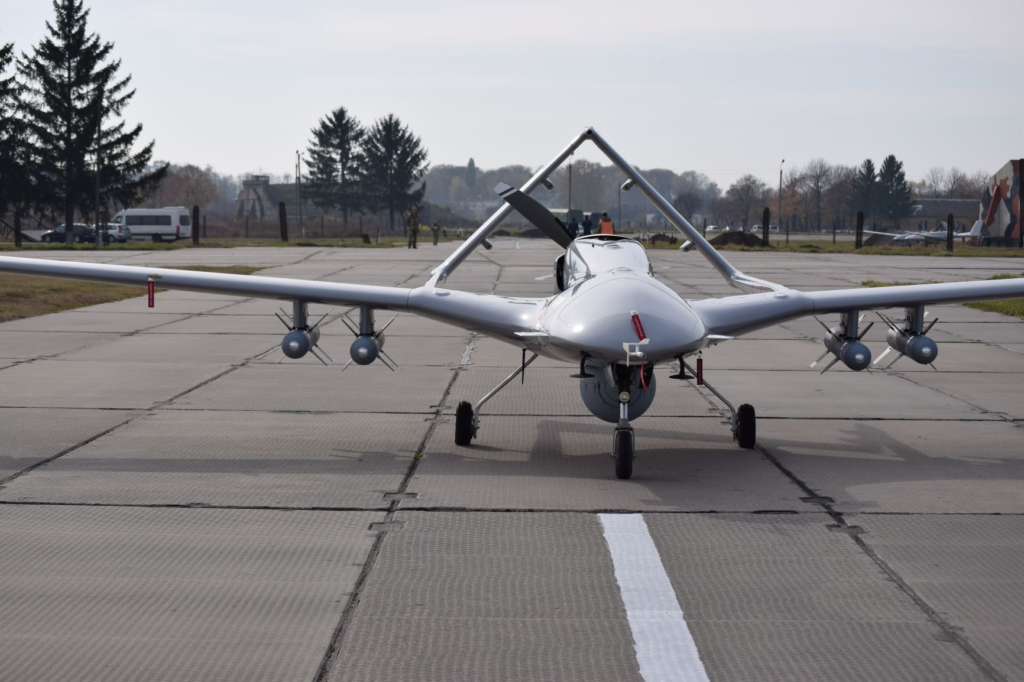
The MALE – medium altitude long endurance class’s Bayraktar TB-2 unmanned aerial vehicle flies at medium altitude and is extremely autonomous. At the 2014 Istanbul Airshow, the Bayraktar TB2 was first displayed to the public.
Features
A single Rotax 912 internal combustion engine producing 105 horsepower powers this weaponized drone. It has a top speed of more than 220 kilometers per hour. The drone has a fuel capacity of 300 liters. The range can go up to 300 kilometers. 5.48 kilometers is the operational altitude. The greatest height is 7.62 kilometers, and the maximum loitering time for this drone is 27 hours.
The maximum payload capacity for this attack drone is 330.693 lbs (150 kg). It has a capacity of four MAM-C or MAM-L missiles. These missiles were created specifically for unmanned aerial vehicles and small assault aircraft.
These missiles can hit both fixed and moving targets and feature laser guidance. A multipurpose warhead with armor-piercing, high explosive and incendiary effects is available for the MAM-C. The MAM-L is also offered with thermobaric and multipurpose warheads.
As a military reconnaissance drone with a maximum control range of up to 150 kilometers, the Bayraktar TB-2 can be utilized for both reconnaissance and the destruction of selected targets. It has target designators, laser rangefinders, modular electron optical and infrared cameras, which are essential for ammunition control, as well as the multifunctional array radar, or MFAR.
In order to disable outdated air defense systems, the gadget can also be equipped with a transportable electronic warfare module. Software on the drone itself constantly calculates its precise coordinates and the best possible possibilities for drone routes when carrying out a mission.
The drone has a length of 6.5 meters and a wingspan of 12 meters, making it a very substantial structure weighing 650 kilos. Three hundred liters or so of fuel are stored in the tank. One hundred fifty kilos make up the payload of the Bayraktar TB2, of which 55 are made up of the electro-optical targeting and reconnaissance equipment.
The Bayraktar TB2’s maximum firing range of 15 kilometers enables users to efficiently hit targets without being seen, especially if the aggressor does not anticipate an attack or lacks electronic systems for spotting unmanned aerial vehicles.
The Armed UAV Bayraktar TB2 is a versatile platform since it has an onboard laser pointer that it can use for target acquisition and four smart munitions in its payload that it can use to destroy targets. Bayraktar TB2 provides all the cutting-edge options needed to execute surgically precise strikes without causing extensive harm to nearby locations.
Conflicts
The Turkish Pantsyr was the target of this attack drone’s initial publicity. Some reports say these drones were responsible for destroying many Russian-made Pantsyr-S1 short-range air defense systems during military operations in Syria and Libya.
By 2022, the Bayraktar TB2 had been used in a number of battles, resulting in the destruction of eleven Pantsyr-S1 systems, even if some of these drones were also destroyed by enemy fire.
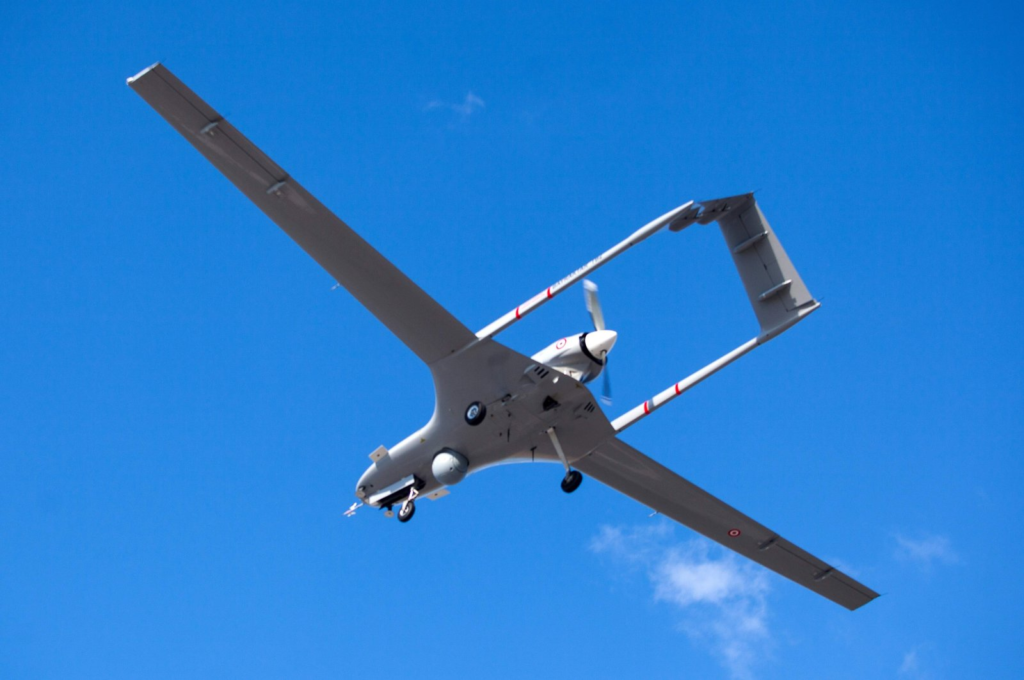
This UAV was deployed by Azerbaijani forces to destroy Armenian Osa-AKM air defense installations in 2020 during a military war between the two countries.
This attack drone proved to be a tough nut for antiquated air defense networks. Drones from the Ukrainian Bayraktar TB2 fleet were responsible for the destruction of many Russian Pantsyr, Tor, and Buk anti-aircraft systems in 2022.
MQ-9 Reaper VS Bayraktar TB-2
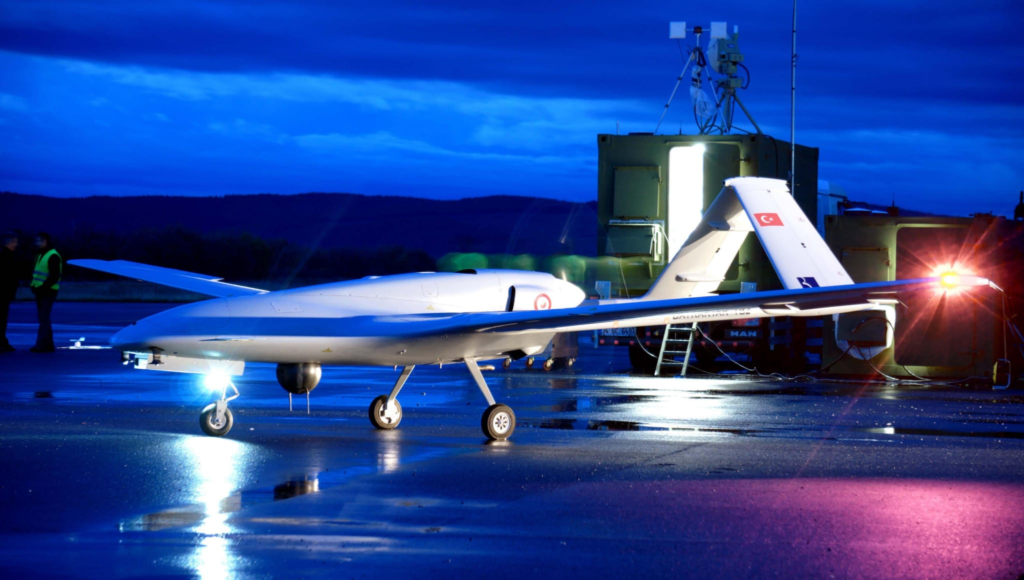
General:
| Name: | General Atomics MQ-9 Reaper | Bayraktar TB2 |
| Type: | Long-endurance, high-altitude | Medium altitude long endurance |
| Origin: | United States | Turkey |
| Produced: | 2007 | 2011 |
Tech Specs:
| Specs: | MQ-9 Reaper | Bayraktar TB2 |
| Range: | 1,900 kilometers (1,200 mi) | 150 kilometers |
| Max speed: | 482 kilometers /hour | 220 kilometers /hour |
| Service ceiling: | 15,420 meters | 8,200 meters |
| Weight empty: | 4,901 lbs (2,223 kg) | 1102 lbs (500 kg) |
| Weight max: | 10,494 lbs (4,760 kg) | 1,430 lbs (650 kg) |
| Armament: | 7 hardpoints, on the two inboard weapons stations 1500 lbs, on the two middle stations 750 lbs, on the outboard stations 150 lbs | 4 hardpoints for laser-guided smart munition |

Dimensions:
| Length: | 11 meters | 6.5 meters |
| Width: | 20 meters | 12 meters |
| Height: | 3.81 meters | 2.2 meters |
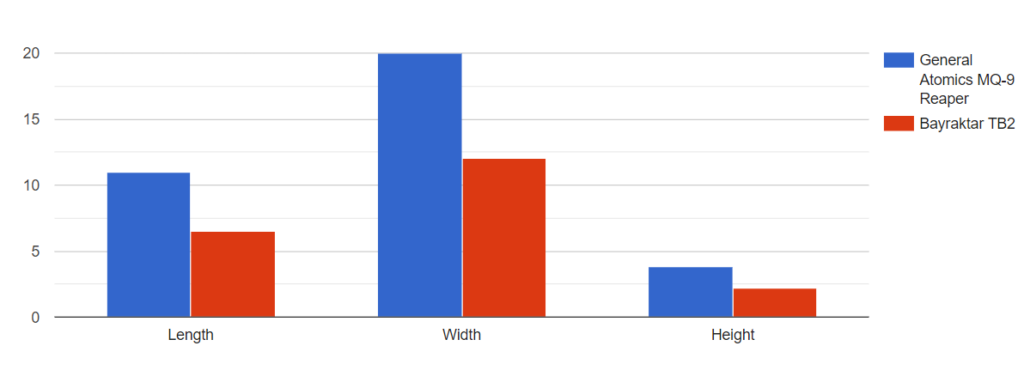
Speed:
MQ-9 Reaper
There is a range of about 130–170 kilometers per hour for the cruise speed. About 100 kilometers per hour is the drone’s stall speed. The device ranges roughly 1250 kilometers and can fly for about 24 hours without refueling.
Bayraktar TB-2
However, the Bayraktar TB-2 is not particularly fast. The propulsion system is a single road tax 912 engine with 100 horsepower, which allows the structure to reach 220 kilometers per hour. However, unlike jet engines seen in modern fighter planes and passenger jets, this engine is a piston unit.
Cost:
According to David Hambling of Intelligent Aerospace, the price tag for each MQ-9 Reaper has increased from $14 million to $32 million, making them more expensive than an Apache attack chopper.
The Bayraktar TB2 has a unit price of roughly $5 million. The price tag for the drone control unit is likewise estimated to be over $5 million, based on contracts with the Ukrainian government. In 2022, Lithuanians started a donation drive to sponsor the purchase of Bayraktar TB-2 drones for the Ukrainian armed forces. Funds of $5,000,000 were collected in just three days.
FAQ
- What does the MQ-9 Reaper do?
- The MQ-9 Reaper is primarily used against dynamic execution targets and secondarily as an intelligence collection tool; it is a multi-mission, armed, medium-altitude, long-endurance remotely piloted aircraft.
- How much does an MQ-9 Reaper cost?
- The original price tag for each MQ-9 reaper was $14 million, but it has since more than risen to $32 million.
- How long can an MQ-9 Reaper fly?
- MQ-9A has a payload capacity of 3,850 lbs, including 3,000 lbs of external supplies, a range of 15240 meters (50,000 feet), and a maximum speed of 240 KTAS, providing it with unrivaled operational versatility.
- How much does Bayraktar cost?
- The Bayraktar TB2 has a unit price of roughly $5 million. The price tag for the drone control unit is likewise estimated to be over $5 million, based on contracts with the Ukrainian government.
- How many countries have Bayraktar TB2?
- Currently, Turkey, Qatar, Ukraine, and Azerbaijan are served by 257 Bayraktar platforms.
- Why is Bayraktar so effective?
- The medium-altitude long-endurance (MALE) platform capability of the Bayraktar TB2 unmanned aerial vehicle (UAV) drones is cited as the reason for their efficacy. It is a solid, field-tested system.
- How many Bayraktar does Ukraine have?
- Over the past few years, Ukraine has purchased more than 20 Bayraktar TB2 armed drones from Baykar, and on January 27, 2022, they placed an order for another 16.

